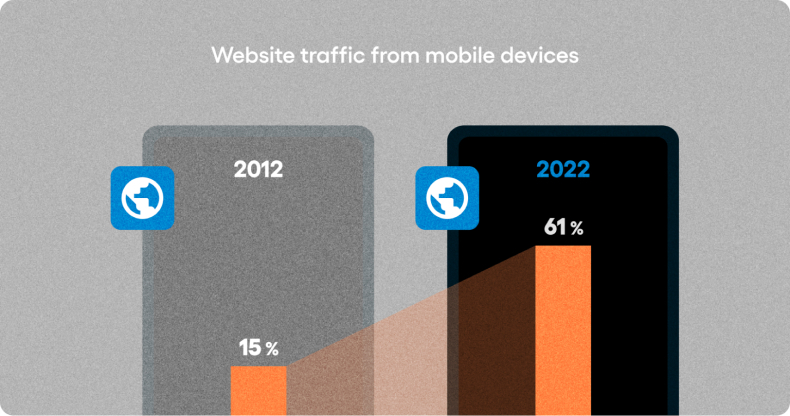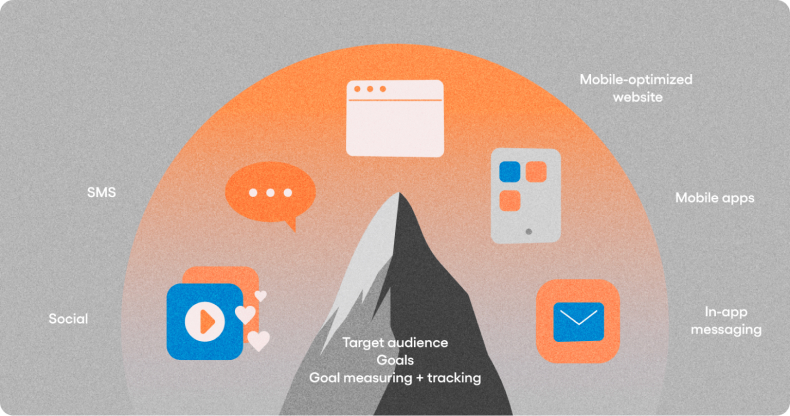Step by step mobile marketing guide

As a subset of digital marketing, mobile marketing is quickly becoming important for businesses of all sizes and across all sectors.
Why now?
Because mobile devices are ubiquitous.
At the end of 2022, more than 61% of web usage was conducted via mobile devices. A decade ago, in 2012, mobile accounted for less than 15% of all web traffic.

That’s a lot of growth.
We’re here to help you boost your mobile app marketing so you can make sure you’re always getting in front of your ideal audience.
In this step-by-step guide, you’ll learn:
- What it means to be a mobile marketer
- How to get your mobile marketing campaign started in 4 steps
- 8 core channels every effective mobile marketing strategy should consider
- Tips for optimizing your messaging for new mobile marketing channels
- The top 4 advantages of mobile marketing

[FREE TOOL] How does your app's engagement score compare to industry standards?
What is mobile marketing?
Mobile marketing is a specific marketing strategy that focuses on a variety of mobile channels to get products or services in front of potential customers who are using those channels.
These channels include:
- Mobile applications
- Mobile-friendly websites
- SMS (aka text messaging)
- Social media
- Push notifications
- In-app chat
… and even more we’ll talk about later.
With mobile marketing, marketers should consider more than just the channels. They also have to think about how messaging comes across on these channels — for example, some channels are more concise, some more casual, etc. — as well as what it actually looks like across a wide variety of handheld screens.
A unique aspect of mobile marketing is that it has the power to be delivered based on location, since a key feature of mobile devices is the location services functionality that knows where the device is at all times — and therefore where its owner is, too.
Ready to level up your marketing program to ensure you’re taking advantage of the unique and in-demand characteristics of mobile marketing?
Good, because that’s up next.
Get your mobile marketing strategy off the ground in 4 steps
As is the case with many thoughtful business strategies, there is no singular list of steps everyone can just copy and paste to come up with a great mobile marketing campaign.
Creating successful mobile marketing is a two-fold process:
- Laying a foundation based on planning around your company’s unique goals, etc. — which we’ll cover in this section.
- Layering in the specific channels and tactics that make the most sense for your staff and your audience — which we’ll cover throughout the rest of the article.
Here’s how to construct the core of your mobile marketing strategy.
1. Outline your target audience
Who is your message for?
Knowing your audience is acutely important when it comes to messaging. You don’t want to come off as stuffy when you’re trying to connect with a casual audience of young gamers. And missing the mark will cost you business.
And in the case of mobile marketing, who your audience is will also drastically impact which channels you choose to focus on.
For example, if your target audience is financial services C-suite personnel, you may make more headway by catching their eye with in-app marketing messaging versus SMS marketing that they might not check very often during the day.
2. Set your goals
Of course, another critical step in developing great mobile marketing is putting clear goals in place for the program.
With objectives that are both clear and clearly communicated, your team as well as team leaders like yourself will be able to ensure your marketing efforts are paying off — and ready to pivot the moment traction seems to be waning.
And as exciting as it is to dive into mobile-specific marketing, remember these goals also need to be measurable as well as attainable. As soon as you see what you can do with mobile marketing, you can hike those goals up even higher for next quarter.
3. Define your goal-tracking system
You’re going to need a way to measure and track performance against all those goals you just set.
This step is all about testing and finding the marketing tool that fits you best. Many marketers are already familiar with Google Analytics, which can be plugged into both websites and mobile apps to view user activity and identify patterns.
If you want to branch out from Google Analytics, what you want to look for are product analytics platforms like Pendo, Amplitude, Kissmetrics, and similar.
4. Implement your mobile marketing channels
Get ready to get tactical, because it’s implementation time (cue Kenny Loggins’ “Danger Zone”).
This means firing up — or optimizing, if you’re already using them — those mobile channels that you’ve identified will align with your audience and help achieve your marketing goals.
Join us in the next section to talk about some of the best channels to choose from.
8 core channels for building an effective mobile marketing strategy
Now, we’re going to discuss the best mobile marketing channels through which to generate leads.
The channels you choose to implement should ultimately depend on the types of devices your target buyers use, where they tend to hang out on the internet, and what content formats they love to consume.
1. A great mobile app
Considering we’re talking about mobile marketing you probably saw this coming, but we have to say it — a really well-designed mobile app is the best place to reach a mobile audience.
A well-designed mobile app has a user experience that’s easy for people to navigate and has the content and/or features that keep them coming back every time they need what you offer.
For example, a great food delivery app makes it exceedingly easy to order food when you want it, to where you want it. A great doctor’s office app makes it easy for patients to schedule follow-up appointments, and may also host some helpful content to help them learn about good health practices and so on. You get the point.
In addition, great apps also need to be discoverable by their target audience. By using SEO best practices to optimize your Google Play and Apple App Store descriptions to align with the terms your ideal users search, you should be able to get in front of more folks who are more likely to download your app.
How do you engage your mobile users beyond the content, features, and maybe a few ads within your app?
Through in-app messaging.
2. In-app messaging
In-app marketing messaging is a mobile marketing channel within a channel.
With in-app messaging, you can market to users in a couple of ways. Namely, via one-to-one messages and push notifications.
With push notifications, you’ll be able to quickly, and often automatically, send engaging campaigns and promotions that nurture the relationship and turn browsers into buyers.
And one-to-one in-app messages make your app more dynamic with a bi-directional channel where buyer-seller conversations can flourish. Drive up conversion rates by putting marketing and customer support at the user’s fingertips with easy-to-use in-app messaging.
Unfortunately, “easy to use” can quickly become “expensive to build” when it comes to mobile apps. However, that’s not the case with Sendbird, the leading communications API platform.
Use Sendbird to add in-app marketing messaging (as well as voice and video chat!) to your application using our pre-build SDKs, APIs, webhooks, and UI kits.
For tips on how to use in-app chats and notifications to connect with consumers, check out our guide to in-app messaging examples.
3. A mobile-ready website
Right after the need for a great mobile app comes the need for a great mobile-ready website.
If your app is your product, this channel may not be necessary. But for the rest of you, a mobile-ready website is key.
What does mobile-ready mean exactly?
Mobile-ready websites are optimized for viewing and use on both desktop and mobile devices, including phones and tablets. This is known as being “responsive.”
Today, people navigate between their mobile and desktop devices all the time. You don’t want it to matter where your mobile marketing campaign takes them. Users should be able to enjoy a seamless customer experience, no matter which campaign they click through or whatever device they use to consume your marketing content.
A mobile marketing strategy made easy. Here’s mobile marketing basics, benefits, and core marketing channels.
4. Location-based marketing
Location-based marketing is a channel that’s pretty much unique to mobile marketing.
When you know a user’s location, you can send messages and notifications that align with the weather they’re experiencing, their proximity to your business location, their proximity to a competitor’s location, and so on.
With location-based marketing, you have the power to serve hyper-personalized and relevant messaging that may encourage them to take buying action more readily than a stale, generic campaign would.
5. Mobile paid search
Some search engines, such as Google, have a different system for creating ads to be displayed on mobile than they do for ads to be displayed on desktop.
Wherever you’re engaging in paid advertising as part of your digital marketing strategy, you want to make sure you’re optimizing your ads so that they look perfect when displayed on different mobile screens.
To learn more about making the most of mobile ads on Google, start here. Running Facebook ads? Check out their mobile studio.
6. SMS (aka text messaging)
SMS marketing, or short message service, is just another way to say text message-based marketing.
With SMS marketing, you’re able to get right in front of your ideal audience in a way they’re certain to see. Most of us check our texts at least a few times a day, right?
That same intimacy is the reason why you must be very careful with this mobile marketing channel. You should always have users opt-in before sending SMS marketing, and you should also have a really good reason for texting them.
Here are some non-annoying topics you can text your audience about to encourage action on their part:
- Brand events
- Sales, discounts, coupons, etc.
- New product or service launches
- Polls or surveys (bonus points if they get a reward for participating)
7. Social media
Social media is a channel that’s most often engaged with via mobile devices. After all, many platforms are built specifically for use on smartphones. Think TikTok, Instagram, etc.
That means whatever social media marketing you’re doing needs to be optimized for consumption on mobile — as well as for the specific channel.
A 300-word Instagram caption may not be approachable for your audience, but a 300-word LinkedIn post may be. Or, a link to a particularly heavily-featured, desktop-optimized page from inside your product or web app may not be the ideal thing to share to mostly mobile consumers.
The point here is: Always consider the audience.
8. Email
About half of email opens happen on mobile devices.
And, mobile users check their email more often than those who don’t use mobile devices.
In other words, like social, email marketing is another place where you should be thinking about mobile marketing best practices:
- The platform you use for delivery should be mobile-friendly
- Your design should be minimal, so it can load anywhere
- The message should be catered to mobile consumption — easy to read, easy to act on
- Any links to your product or service should be to mobile-optimized destinations

Tips for optimizing your messaging for mobile marketing channels
We’ve mentioned a few times now how you may need to tweak the way you create marketing messaging so that it’s optimized for on-the-go consumption.
Here are some ways to do just that:
- K.I.S.S.: Keep it simple! Communication on most mobile channels is casual and concise. Keep that in mind and leave the long-winded jargon behind to engage via mobile.
- Personalize: You know a lot from device data — where your audience spends time, the apps they use, their demographics, etc. Use that to your advantage for personalized messaging they actually want to click on.
- Prioritize real time: Like we touched on, the immediateness of mobile marketing is one of its strongest points. Lean into that by sending messages that inspire action right now: texts about events in their area, emails that let recipients know their discount code expires at the end of the day, etc.
- Call to action: Most marketing messages should entice users to take a next step — whether that’s deeper into the funnel or all the way through to a signup or purchase. This is even more important to prioritize in mobile messaging, as folks on their devices may be more ready to act in the moment.
- Always be iterating: We can’t say this enough. For any marketing campaign really, execution alone is not enough for success. Execute, test, iterate, repeat.
- Don’t overstep: Marketing campaigns should only be sent to users who opted in, and they should be easy to opt-out of. Don’t be sketchy. End of discussion.
4 advantages of mobile marketing
Still need just one more push to convince you it’s time to spend some time on mobile-specific marketing channels and messaging?
Well, we’ll give you four.
Mobile marketing is fast
Not only can you better share events, discounts, etc. as they’re taking place with mobile marketing — recipients can take action on that messaging immediately!
Meets customers where they surf
As we know, the majority of the world is now surfing the web from a mobile device. So why would you waste time and money marketing to them anywhere else? The best campaigns are the ones that meet your audience where they’re already at.
Often more affordable
Again looking at more traditional marketing methods like billboards or TV spots, mobile marketing often offers more engagement and more measurable results for less money.
On top of that, your own team can create and run marketing campaigns — saving you big time on an expensive external agency.
Location element makes mobile marketing super effective
Almost 90% of marketers have reported seeing increased sales after using location-based marketing tactics.
The majority also saw growth in their customer bases, better customer engagement, increased ROI, and many other benefits.
There are few other ways to take advantage of location in marketing the way mobile-focused marketing can.
Enjoy more engagement with mobile marketing
With this guide in front of you, you’re prepared to shift how you handle certain channels and optimize your approach for your mobile-first audience.
If that means building new features into your mobile app — don’t shy away. Welcome the change with Sendbird.
At Sendbird, we’re committed to making it fast, easy, and affordable for businesses to build core engagement features into their apps, including text chat, voice and video chat, customer support management, an in-app inbox, and more.
What used to take agencies months and tens of thousands of dollars to custom build, your team can now do in days for a reasonable, flexible fee with Sendbird.
Let us handle the communication tools and we’ll help you get back to doing what you do best: creating awesome mobile marketing campaigns that engage high-potential leads.










